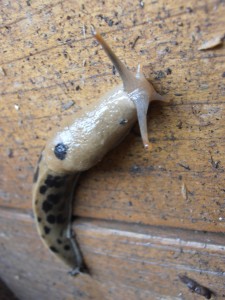I can’t announce the details quite yet, but I’m delighted to have a new nonfiction adaptation in the works. It will be an illustrated book for kids 8 to 12 years old on a fascinating topic in animal behavior. The original book is wonderful, well researched and entertaining; it will be fun as well as challenging to adapt it for a younger audience.
Category Archives: Animals
Sluggo
Just now when I took the cat for a walk I spotted this 6-inch beauty on our retaining wall. I love these guys. In the lower right that thing that looks like a rat dropping is a much smaller slug, clearly thinking, “When I grow up, I want to be just like you, Dad.”
Over the Arachnids at last
Today I finally finished and sent in the ms. for a book on Arachnids that is part of a kids’ series I’m doing on various taxons: flowering plants, primates, rodents, marsupials (that one was a treat to research and write!), and so on.
I suspect that my editor rather enjoyed having me do the Arachnids book, knowing that I am a pronounced arachnophobe. Or at least a spider-phobe. I’ve never seen a live scorpion, amblypygid, uropygid, or member of many of the smaller arachnid orders. I don’t know how I’d react to them, but I doubt I’d be as shocked and repelled as when a spider scuttles out from beneath my hairbrush. Nonetheless, they are truly fascinating creatures, and it was quite a lot of fun to write about them.
This was actually my second book about spiders. Some years ago I wrote a picture book about them for very young kids. The one I finished today was for middle-school kids. I’ll be finishing up this current series soon, and I’ll be sad to see it end. It’s going out with a whimper, too. The last book is going to be about, Dawkins help me (and I mean that literally, as I have found some useful material in The Ancestor’s Tale), bacteria.
